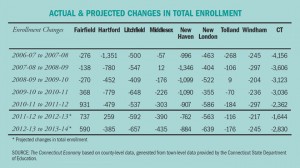
Connecticut schools will have a good opportunity to consider education reform measures without widespread disruption over the next two years, thanks to relatively flat enrollment patterns around the state, according to an analysis by University of Connecticut economics professor Dennis Heffley.
In an article for the summer issue of The Connecticut Economy, released today, Heffley writes that enrollment projections point to a relatively calm two years for Connecticut, without the surges in student populations that are swamping some other states.
“Change is seldom comfortable or easy, but the recent and projected lull in enrollment growth throughout much of the state ought to facilitate adjustments,” Heffley writes.

Heffley’s projections estimate that Fairfield County will be alone in seeing growth in the next two school years, but those increases will be modest, amounting to roughly 1,300 students. The state’s seven other counties will likely see drops in enrollment but, as with Fairfield, the numbers will be small.
Overall, Heffley estimates that K-12 schools in Connecticut will lose about 1,644 students in the 2012-2013 school year, and roughly 2,830 students the year after. According to the state Department of Education website, K-12 enrollment in Connecticut this year is roughly 557,000.
Connecticut, like most states, is in the midst of a wide-ranging conversation about improving schools, even as the state’s public schools generally fare well in comparison with other states. A new education reform bill signed last month by Gov. Dannel P. Malloy will bring significant change to the state’s schools, which also recently won a waiver from the federal government enabling Connecticut greater flexibility under the No Child Left Behind law.
Debate over which measures are best will undoubtedly continue, Heffley writes, “but this may be an opportune time, without the added pressure of coping with rapidly expanding enrollment, to find the common ground that usually offers sensible answers to such debates.”
Enrollment projections at the county level offer a big-picture glimpse at the state, but fluctuations in towns and individual districts may be more significant, Heffley writes. His analysis found that towns with a combination of factors he dubs “the right stuff” are better able to absorb major fluctuations in enrollment.
Those factors are: an ample property tax base, a willingness to raise taxes as reflected in mill rates, adequate support from the state or federal governments, a relatively concentrated population, and a sufficient ratio of non-students per student.
Together, those account for almost 57 percent of the variation in the most recently available figures on per-pupil spending in Connecticut schools, which in 2010 ranged from $10,521 in Ansonia to $20,777 in Sharon.
“Towns that are not so blessed,” writes Heffley, “will find a bitter pill in enrollment shifts and reform-driven mandates.”
The Connecticut Economy is a publication of UConn’s Department of Economics.



